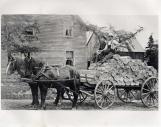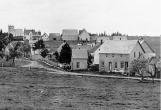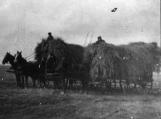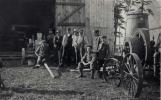1
There above the mist on rising knoll,Clearly seen from Baron's winding road,
Rise the schoolhouse and churches two
Above the hush of Minudie.
Like a whisper out of Fundy's Bay
At the close of day, the gauze-like fog
Creeps acorss the Elysian Fields,
Above which, haystacks float eerily.
Over quiet Minudie it creeps,
The village with its rolling hills lies
Dreaming its old Acadian dreams,
Dreams of long vanished prosperity
Francis Dawson
Past resident & student of Minudie School 1923-5
2
A view of the village of Minudie during the 1930's, showing the boardwalks.1930
Minudie, Nova Scotia
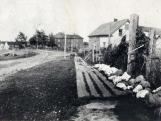
3
During the time of Amos Seaman, Minudie became a bustling community. The fertile marshland provided excellent farming, there was a plentiful supply of shad and the grindstone, shipping and lumber industries provided alternate sources of employment.This photo shows part of the village with the boardwalks, taken in the 1920's.
4
The lumber mill located at Mill Creek, close to Minudie, owned and operated by the Seaman family.1890
Minudie, Nova Scotia

5
There was an active lumber business in the area, with several mills the main one being located in nearby Mill Creek. This provided the material for the homes and business in Minudie, and cargo for the shipping trade, as the following extract from the Gilbert Seaman Diary shows:June 1879
Tue. 3 Schr. Edward Burton finished loading for Hayti with pine boards - scantling & shingles.
6
Two sleds with teams of horses hauling them through the snow, taken in the late 1800's.1890
Minudie, Nova Scotia

7
The lumber business was very succesful, especially as the village of Minudie grew.This photo, taken in the late 1800's shows teams of horses hauling the logs on sleds.
9
This photo shows two local men hauling a load of lathes.The lumber industry was very profitable, with several smaller mills in the area. However, when disaster struck in the form of a freshet in the spring of 1884, it wrought havoc on this industry and the livelihood of many. (A freshet is a sudden overflow of water, resulting from a heavy rain or thaw).
April 1884
Wed. 23 Mild morning, the rain apparently over. The river full of drifting logs, deals, and shingles. Some of the Mill dams washed out, the dykes on the River Hebert are said to be broken.... This has been the greatest freshet known. At noon, it is reported that the dams of both Young's and Kelley's at River Hebert are broken and the mill of the latter partly taken away.
8 p.m. - The reports from River Hebert is that Young and Kelley's losses of logs, lumber, etc. are quite large.
Fri. 25 The result of the freshet so far is:
B. Young's Mill, River Hebert 4 million feet of logs lost, and a general loss of 20,000$. Kelley Bros. Mill logs & lumber 15,000$. The bridge over head of River Hebert and the bridge at Kelley's Mills both gone. Kellam's Mill, Halfway River, dam gone. White of Apple River, dam and logs gone. Jones of Moose River, dam broke and took about 11,000$ of ship timber. At River Philip, a general sweep of dams. Lots of wash outs all along the Intercolonial Railway and reports of severe freshets through New Brunswick and Maine.
11
This photo is of the village around the early 1900's. The first building (far left) is the old creamery, (the upstairs was also used as a dance hall), next door is Captain Downey's house (one of the ferry captain's), Amos Vernon home, the Jerome LeBlanc Store, the blacksmiths and the Vernon house on top of the hill.Gilbert Seaman refers to the blacksmiths in Minudie in 1886, during his diary.
Jotham Smith - Blacksmith, specially goods for forks, Jesuharps, etc.... In Mr. Smiths time he ws one of three noted Blacksmiths in this place when most of the work for Barronsfield, the Joggins, River Hebert, Rockport, N.B., etx. was done here - all Joggin Tools were made here. The other two were James Clarke who resided ar Clark's Point.....W.W. Pride who had his shop near the present wharves....
13
From the time of the Acadian settlers, farming had been a necessity and with the fertile marshland reclaimed by the dykes, a very successful venture in Minudie. These early settlers found that unlike most other settlements, they could keep their livestock all winter, by feeding them the marsh hay.Amos Seaman also realised the potential of the marsh hay, when he began shipping it to Boston in 1810.
The practise of shipping hay from Minudie continued, as mentioned in Gilbert Seaman's diary.
April 1878
Mon.1 Aloe with preped hay for Saint John.
Thurs.11 Fine day, 4 boats from Rockport here today for hay, took away about five tons.
November 1878
Thur. 28 Schr. Jennette T. Hibbard at Lower Cove taking in potatoes fro N. York at 50/ per bushel and Schr. Pokahontas at Upper Wharf loading hay for St. John.
